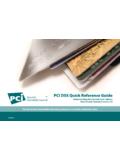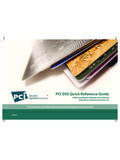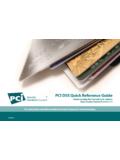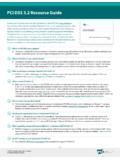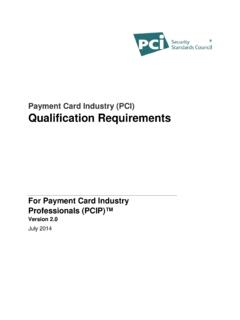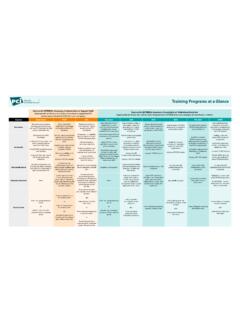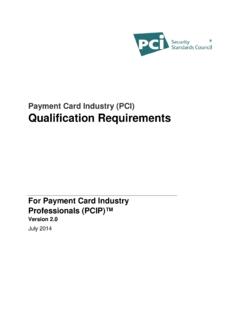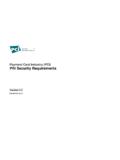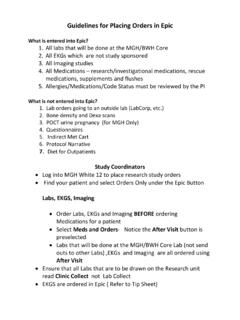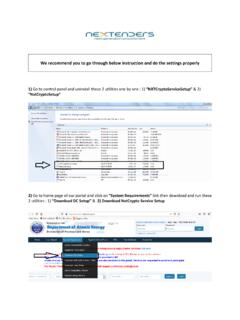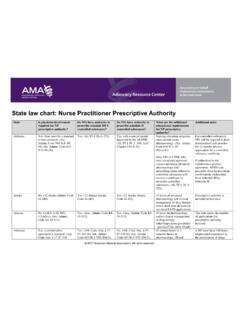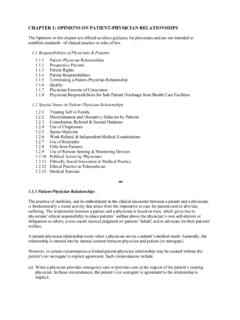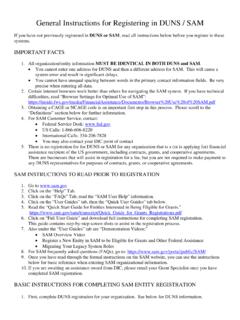Transcription of PCI DSS Cloud Computing Guidelines
1 Standard: PCI Data Security Standard (PCI DSS) Version: Date: February 2013 Author: Cloud Special Interest Group PCI Security Standards Council Information Supplement: PCI DSS Cloud Computing Guidelines Information Supplement PCI DSS Cloud Computing Guidelines February 2013 i The intent of this document is to provide supplemental information. Information provided here does not replace i or supersede requirements in any PCI SSC Standard. Table of Contents 1 Executive Summary .. 1 Intended Use .. 1 Audience .. 2 Terminology .. 2 2 Cloud Overview .. 3 Deployment and Service Models .. 3 3 Cloud Provider / Cloud Customer Relationships .. 6 Understanding Roles and Responsibilities.
2 6 Roles and Responsibilities for Different Deployments Models .. 6 Responsibilities for Different Service 7 Nested Service-Provider Relationships .. 9 4 PCI DSS Considerations .. 10 Understanding PCI DSS Responsibilities .. 10 PCI DSS Responsibilities for Different Service Models .. 10 Security as a Service (SecaaS) .. 12 Segmentation Considerations .. 12 Scoping Considerations .. 15 5 PCI DSS Compliance Challenges .. 18 What does I am PCI compliant mean? .. 19 Verifying Scope of Validated Services and Components .. 19 Verifying PCI DSS Controls Managed by the Cloud Provider .. 20 6 Additional Security Considerations .. 22 Governance, Risk and Compliance .. 22 Facilities and Physical Security.
3 24 Data sovereignty and Legal considerations .. 24 Data Security Considerations .. 25 Technical Security Considerations .. 27 Incident Response and Investigation .. 31 7 Conclusion .. 32 Appendix A: Sample PCI DSS Responsibilities for Different Service Models .. 33 Appendix B: Sample Inventory .. 39 Appendix C: Sample PCI DSS Responsibility Matrix .. 41 Appendix D: PCI DSS Implementation Considerations .. 43 Acknowledgements .. 48 References .. 49 About the PCI Security Standards Council .. 50 1 The intent of this document is to provide supplemental information. Information provided here does not replace 1 or supersede requirements in any PCI SSC Standard. Information Supplement PCI DSS Cloud Computing Guidelines February 2013 1 Executive Summary Cloud Computing is a form of distributed Computing that is yet to be standardized1.
4 There are a number of factors to be considered when migrating to Cloud services, and organizations need to clearly understand their needs before they can determine if and how they will be met by a particular solution or provider. As Cloud Computing is still an evolving technology, evaluations of risks and benefits may change as the technology becomes more established and its implications become better understood. Cloud security is a shared responsibility between the Cloud service provider (CSP) and its clients. If payment card data is stored, processed or transmitted in a Cloud environment, PCI DSS will apply to that environment, and will typically involve validation of both the CSP s infrastructure and the client s usage of that environment.
5 The allocation of responsibility between client and provider for managing security controls does not exempt a client from the responsibly of ensuring that their cardholder data is properly secured according to applicable PCI DSS requirements. It s important to note that all Cloud services are not created equal. Clear policies and procedures should be agreed between client and Cloud provider for all security requirements, and responsibilities for operation, management and reporting should be clearly defined and understood for each requirement. Intended Use This document provides guidance on the use of Cloud technologies and considerations for maintaining PCI DSS controls in Cloud environments. This guidance builds on that provided in the PCI DSS Virtualization Guidelines and is intended for organizations using, or thinking of using, providing, or assessing Cloud technologies as part of a cardholder data environment (CDE).
6 This document is structured as follows: Executive Summary Includes a brief summary of some key points and provides context for the remainder of the document. Cloud Overview Describes the deployment and service models discussed throughout this document. Cloud Provider/ Cloud Customer Relationships Discusses how roles and responsibilities may differ across different Cloud service and deployment models PCI DSS Considerations Provides guidance and examples to help determine responsibilities for individual PCI DSS requirements, and includes segmentation and scoping considerations. PCI DSS Compliance Challenges Describes some of the challenges associated with validating PCI DSS compliance in a Cloud environment.
7 Additional Security Considerations Explores a number of business and technical security considerations for the use of Cloud technologies. Conclusion Presents recommendations for starting discussions about Cloud services. 1 NIST Guidelines on Security and Privacy in Public Cloud Computing (SP SP800-144) 2 The intent of this document is to provide supplemental information. Information provided here does not replace 2 or supersede requirements in any PCI SSC Standard. Information Supplement PCI DSS Cloud Computing Guidelines February 2013 The following appendices are included to provide additional guidance: Appendix A: PCI DSS Responsibilities for different Service Models Presents additional considerations to help determine PCI DSS responsibilities across different Cloud service models.
8 Appendix B: Sample Inventory Presents a sample system inventory for Cloud Computing environments. Appendix C: PCI DSS Responsibility Matrix Presents a sample matrix for documenting how PCI DSS responsibilities are assigned between Cloud provider and client. Appendix D: PCI DSS Implementation Considerations Suggests a starting set of questions that may help in determining how PCI DSS requirements can be met in a particular Cloud environment. This document is intended to provide an initial point of discussion for Cloud providers and clients, and does not delve into specific technical configurations. This document does not endorse the use of any specific technologies, products, or services. The information in this document is intended as supplemental guidance and does not supersede, replace or extend PCI DSS requirements.
9 For the purposes of this document, all references made are to PCI DSS version Audience The information in this document is intended for merchants, service providers, assessors and other entities looking for guidance on the use of Cloud Computing in the context of PCI DSS. For example: Merchants The security and PCI DSS considerations are applicable to all types of Cloud environments, and may be useful to merchants managing their own Cloud infrastructure as well as those looking to engage with a third party. Guidance for working with third-party Cloud providers and PCI DSS compliance challenges may also be useful. Cloud service providers The security and PCI DSS considerations may provide useful information for CSPs to assist their understanding of the PCI DSS requirements, and may also help CSPs to better understand their clients PCI DSS needs.
10 Guidance on CSP/client relationships and PCI DSS compliance challenges may also be useful for providers. Assessors The security and PCI DSS considerations may help assessors to understand what they might need to know about an environment in order to be able to determine whether a PCI DSS requirement has been met. Terminology The following terms are used throughout this document: CSP Cloud Service Provider. The CSP, or Cloud provider, is the entity providing the Cloud service. The CSP acquires and manages the infrastructure required for providing the services, runs the Cloud software that provides the services, and delivers the Cloud services through network Cloud customer or client The entity subscribing to a service provided by a Cloud provider.

